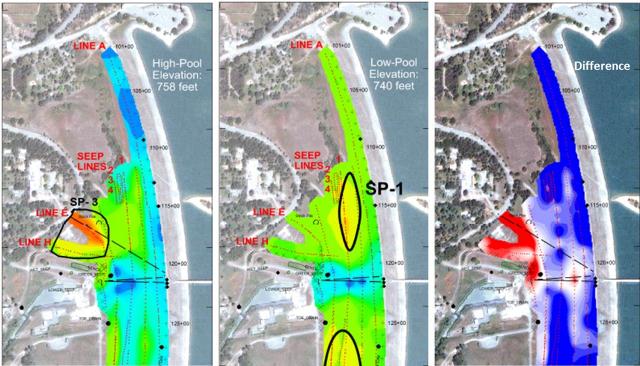Self Potential Method

Overview
A natural voltage difference is always present between points on the earth’s surface. This voltage difference can be due to subsurface water flow through porous media, from dissimilar subsurface metals or soil materials, or even from temporary disturbances in global electrical currents.
The self-potential (SP) method measures this voltage difference across the near surface of an area of concern. It is often used as a non-intrusive way to evaluate the integrity of earthen dams, dikes or levees. more
Underground fluid-flow paths are detected as anomalies in the self-potential field when spurious causes can be eliminated — or at least held constant while varying the head on the flow. Therefore, two surveys are required for reservoir leakage studies, one at low pool and one at high pool. Interpretation of the data is usually qualitative, but provides a useful picture of the location and extent of seepage. A leak due to sheet flow may require additional methods to delineate.
The SP method is used worldwide for engineering hydrologic investigations. The U.S. Army Corps of Engineers regularly performs or contracts for SP surveys as part of seepage studies and the U.S. Bureau of Reclamation includes SP measurements as part of its standard package of geophysics for dam-safety investigations.
Logistics
A low-noise base station is set up and the difference in potential is measured at a number of survey stations in reference to that point. Stations may be along profiles or spaced for area coverage. Crew size is usually one or two persons. Equipment is simple and lightweight. The time needed to conduct the survey depends on the area to be surveyed. more
Measurements are made by contacting the earth (sometimes under water) with non-polarizing electrodes called “porous pots” which are designed not to create spurious chemical potentials on contact. Small holes are dug at each station to place pairs of electrodes into uniform medium, usually moist soil, and measurements are made with a high-impedance voltmeter.
Considerations
Interpretation must account for or ensure that other natural sources of electrical potential are not the cause of an anomaly or overprinting the desired signals. Interference such as buried metallic objects, abrupt resistivity changes, or two- or three-dimensional effects must be accounted for. Telluric noise — naturally-occurring transient potentials — may need to be monitored or predicted from published forecasts of magnetic disturbances, to minimize the signal degradation.
Deliverables
The Self Potential method is often used to provide information to help assess, design, and prioritize needed remediation. Deliverables typically include a map with base station and measurement locations for any time-lapsed repeat surveys, profiles of the SP values, contour maps if sufficient area is surveyed, and a mapped interpretation with written explanation of what the data reveals about fluid-flow location, extent and type.

